DIFFERENTIAL EQUATIONS,
DYNAMICAL SYSTEMS, AND
AN INTRODUCTION
TO CHAOS
Morris W. Hirsch
University of California, Berkeley
Stephen Smale
University of California, Berkeley
Robert L. Devaney
Boston University
AMSTERDAM • BOSTON • HEIDELBERG • LONDON
NEW YORK • OXFORD • PARIS • SAN DIEGO
SAN FRANCISCO • SINGAPORE • SYDNEY • TOKYO
Academic Press is an imprint of Elsevier
�
Academic Press is an imprint of Elsevier
225 Wyman Street, Waltham, MA 02451, USA
The Boulevard, Langford Lane, Kidlington, Oxford, OX5 1GB, UK
c 2013 Elsevier Inc. All rights reserved.
No part of this publication may be reproduced or transmitted in any form or by any means, electronic
or mechanical, including photocopying, recording, or any information storage and retrieval system,
without permission in writing from the publisher. Details on how to seek permission, further
information about the Publisher’s permissions policies and our arrangements with organizations such
as the Copyright Clearance Center and the Copyright Licensing Agency, can be found at our website:
www.elsevier.com/permissions.
This book and the individual contributions contained in it are protected under copyright by the
Publisher (other than as may be noted herein).
Notices
Knowledge and best practice in this field are constantly changing. As new research and experience
broaden our understanding, changes in research methods, professional practices, or medical
treatment may become necessary.
Practitioners and researchers must always rely on their own experience and knowledge in evaluating
and using any information, methods, compounds, or experiments described herein. In using such
information or methods they should be mindful of their own safety and the safety of others,
including parties for whom they have a professional responsibility.
To the fullest extent of the law, neither the Publisher nor the authors, contributors, or editors, assume
any liability for any injury and/or damage to persons or property as a matter of products liability,
negligence or otherwise, or from any use or operation of any methods, products, instructions, or
ideas contained in the material herein.
Library of Congress Cataloging-in-Publication Data
Hirsch, Morris W., 1933-
Differential equations, dynamical systems, and an introduction to chaos. — 3rd ed. / Morris W.
Hirsch, Stephen Smale, Robert L. Devaney.
p. cm.
ISBN 978-0-12-382010-5 (hardback)
1. Differential equations.
2. Algebras, Linear.
3. Chaotic behavior in systems.
I. Smale,
Stephen, 1930–
II. Devaney, Robert L., 1948– III. Title.
QA372.H67 2013
515’.35–dc23
2012002951
British Library Cataloguing-in-Publication Data
A catalogue record for this book is available from the British Library.
For information on all Academic Press publications
visit our Website at www.elsevierdirect.com
Printed in the United States
12 13 14 15 16
10 9 8 7 6 5 4 3 2 1
�
Preface to Third Edition
The main new features in this edition consist of a number of additional explo-
rations together with numerous proof simplifications and revisions. The new
explorations include a sojourn into numerical methods that highlights how
these methods sometimes fail, which in turn provides an early glimpse of
chaotic behavior. Another new exploration involves the previously treated
SIR model of infectious diseases, only now considered with zombies as the
infected population. A third new exploration involves explaining the motion
of a glider.
This edition has benefited from numerous helpful comments from a variety
of readers. Special thanks are due to Jamil Gomes de Abreu, Eric Adams, Adam
Leighton, Tiennyu Ma, Lluis Fernand Mello, Bogdan Przeradzki, Charles
Pugh, Hal Smith, and Richard Venti for their valuable insights and corrections.
ix
�
Preface
In the thirty years since the publication of the first edition of this book, much
has changed in the field of mathematics known as dynamical systems. In the
early 1970s, we had very little access to high-speed computers and computer
graphics. The word chaos had never been used in a mathematical setting. Most
of the interest in the theory of differential equations and dynamical systems
was confined to a relatively small group of mathematicians.
Things have changed dramatically in the ensuing three decades. Comput-
ers are everywhere, and software packages that can be used to approximate
solutions of differential equations and view the results graphically are widely
available. As a consequence, the analysis of nonlinear systems of differential
equations is much more accessible than it once was. The discovery of com-
plicated dynamical systems, such as the horseshoe map, homoclinic tangles,
the Lorenz system, and their mathematical analysis, convinced scientists that
simple stable motions such as equilibria or periodic solutions were not always
the most important behavior of solutions of differential equations. The beauty
and relative accessibility of these chaotic phenomena motivated scientists and
engineers in many disciplines to look more carefully at the important differen-
tial equations in their own fields. In many cases, they found chaotic behavior
in these systems as well.
Now dynamical systems phenomena appear in virtually every area of sci-
ence, from the oscillating Belousov–Zhabotinsky reaction in chemistry to the
chaotic Chua circuit in electrical engineering, from complicated motions in
celestial mechanics to the bifurcations arising in ecological systems.
xi
�
xii
Preface
As a consequence, the audience for a text on differential equations and
dynamical systems is considerably larger and more diverse than it was in the
1970s. We have accordingly made several major structural changes to this
book, including:
1. The treatment of linear algebra has been scaled back. We have dispensed
with the generalities involved with abstract vector spaces and normed lin-
ear spaces. We no longer include a complete proof of the reduction of all
n× n matrices to canonical form. Rather, we deal primarily with matrices
no larger than 4× 4.
2. We have included a detailed discussion of the chaotic behavior in the
Lorenz attractor, the Shil’nikov system, and the double-scroll attractor.
3. Many new applications are included; previous applications have been
updated.
4. There are now several chapters dealing with discrete dynamical systems.
5. We deal primarily with systems that are C
, thereby simplifying many of
∞
the hypotheses of theorems.
This book consists of three main parts. The first deals with linear systems of
differential equations together with some first-order nonlinear equations. The
second is the main part of the text: here we concentrate on nonlinear systems,
primarily two-dimensional, as well as applications of these systems in a wide
variety of fields. Part three deals with higher dimensional systems. Here we
emphasize the types of chaotic behavior that do not occur in planar systems,
as well as the principal means of studying such behavior—the reduction to a
discrete dynamical system.
Writing a book for a diverse audience whose backgrounds vary greatly poses
a significant challenge. We view this one as a text for a second course in differ-
ential equations that is aimed not only at mathematicians, but also at scientists
and engineers who are seeking to develop sufficient mathematical skills to
analyze the types of differential equations that arise in their disciplines.
Many who come to this book will have strong backgrounds in linear algebra
and real analysis, but others will have less exposure to these fields. To make
this text accessible to both groups, we begin with a fairly gentle introduction
to low-dimensional systems of differential equations. Much of this will be a
review for readers with a more thorough background in differential equations,
so we intersperse some new topics throughout the early part of the book for
those readers.
For example, the first chapter deals with first-order equations. We begin
it with a discussion of linear differential equations and the logistic popula-
tion model, topics that should be familiar to anyone who has a rudimentary
acquaintance with differential equations. Beyond this review, we discuss the
logistic model with harvesting, both constant and periodic. This allows us to
introduce bifurcations at an early stage as well as to describe Poincar´e maps
�
Preface
xiii
and periodic solutions. These are topics that are not usually found in elemen-
tary differential equations courses, yet they are accessible to anyone with a
background in multivariable calculus. Of course, readers with a limited back-
ground may wish to skip these specialized topics at first and concentrate on
the more elementary material.
Chapters 2 through 6 deal with linear systems of differential equations.
Again we begin slowly, with Chapters 2 and 3 dealing only with planar sys-
tems of differential equations and two-dimensional linear algebra. Chapters
5 and 6 introduce higher dimensional linear systems; however, our emphasis
remains on three- and four-dimensional systems rather than completely gen-
eral n-dimensional systems, even though many of the techniques we describe
extend easily to higher dimensions.
The core of the book lies in the second part. Here, we turn our atten-
tion to nonlinear systems. Unlike linear systems, nonlinear systems present
some serious theoretical difficulties such as existence and uniqueness of solu-
tions, dependence of solutions on initial conditions and parameters, and the
like. Rather than plunge immediately into these difficult theoretical questions,
which require a solid background in real analysis, we simply state the impor-
tant results in Chapter 7 and present a collection of examples that illustrate
what these theorems say (and do not say). Proofs of all of the results are
included in the final chapter of the book.
In the first few chapters in the nonlinear part of the book, we introduce
important techniques such as linearization near equilibria, nullcline analysis,
stability properties, limit sets, and bifurcation theory. In the latter half of this
part, we apply these ideas to a variety of systems that arise in biology, electrical
engineering, mechanics, and other fields.
Many of the chapters conclude with a section called “Exploration.” These
sections consist of a series of questions and numerical investigations dealing
with a particular topic or application relevant to the preceding material. In
each Exploration we give a brief introduction to the topic at hand and provide
references for further reading about this subject. But, we leave it to the reader
to tackle the behavior of the resulting system using the material presented ear-
lier. We often provide a series of introductory problems as well as hints as to
how to proceed, but in many cases, a full analysis of the system could become
a major research project. You will not find “answers in the back of the book”
for the questions; in many cases, nobody knows the complete answer. (Except,
of course, you!)
The final part of the book is devoted to the complicated nonlinear behav-
ior of higher dimensional systems known as chaotic behavior. We introduce
these ideas via the famous Lorenz system of differential equations. As is often
the case in dimensions three and higher, we reduce the problem of com-
prehending the complicated behavior of this differential equation to that
of understanding the dynamics of a discrete dynamical system or iterated
�
xiv
Preface
function. So we then take a detour into the world of discrete systems, dis-
cussing along the way how symbolic dynamics can be used to describe certain
chaotic systems completely. We then return to nonlinear differential equations
to apply these techniques to other chaotic systems, including those that arise
when homoclinic orbits are present.
We maintain a website at math.bu.edu/hsd devoted to issues regarding
this text. Look here for errata, suggestions, and other topics of interest to
teachers and students of differential equations. We welcome any contributions
from readers at this site.
�
1
First-Order Equations
The purpose of this chapter is to develop some elementary yet important
examples of first-order differential equations. The examples here illustrate
some of the basic ideas in the theory of ordinary differential equations in the
simplest possible setting.
We anticipate that the first few examples will be familiar to readers who have
taken an introductory course in differential equations. Later examples, such
as the logistic model with harvesting, are included to give the reader a taste of
certain topics (e.g., bifurcations, periodic solutions, and Poincar´e maps) that
we will return to often throughout this book. In later chapters, our treatment
of these topics will be much more systematic.
1.1 The Simplest Example
The differential equation familiar to all calculus students,
= ax,
dx
dt
is the simplest. It is also one of the most important. First, what does it mean?
Here x = x(t) is an unknown real-valued function of a real variable t and
(t) for the derivative). In addi-
dx/dt is its derivative (we will also use x
tion, a is a parameter; for each value of a we have a different differential
or x
Differential Equations, Dynamical Systems, and an Introduction to Chaos. DOI: 10.1016/B978-0-12-382010-5.00001-4
c 2013 Elsevier Inc. All rights reserved.
1
�

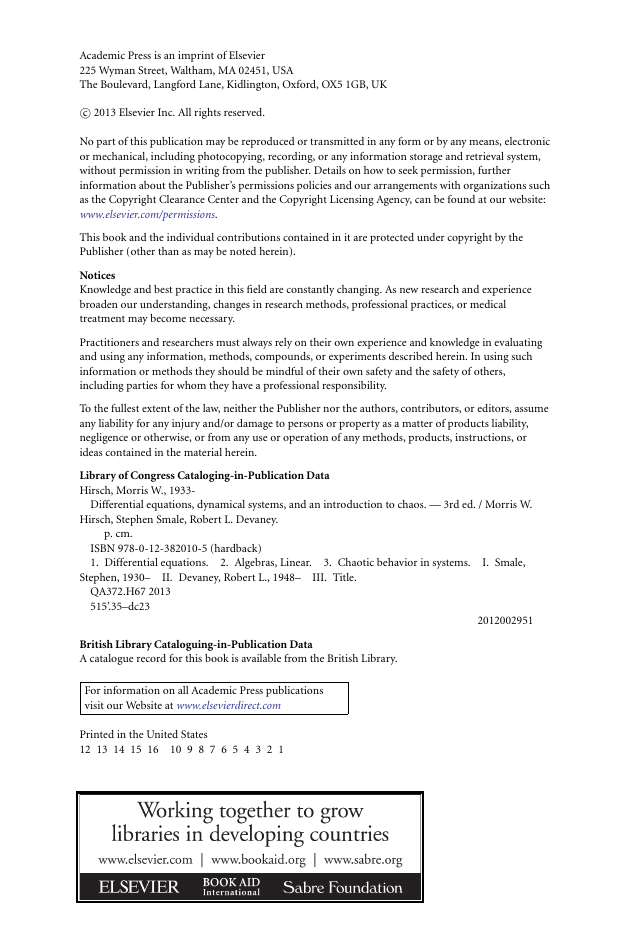
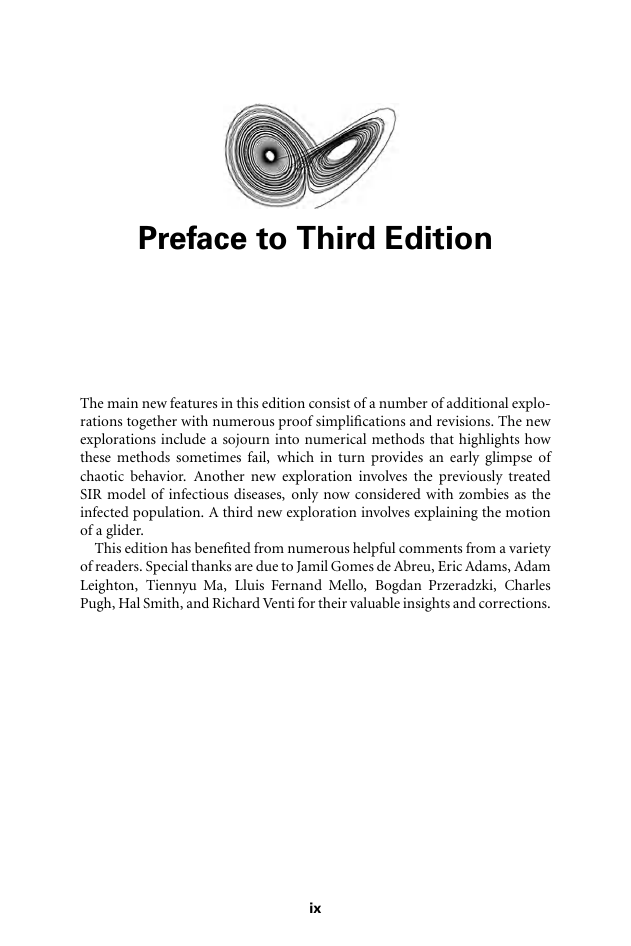

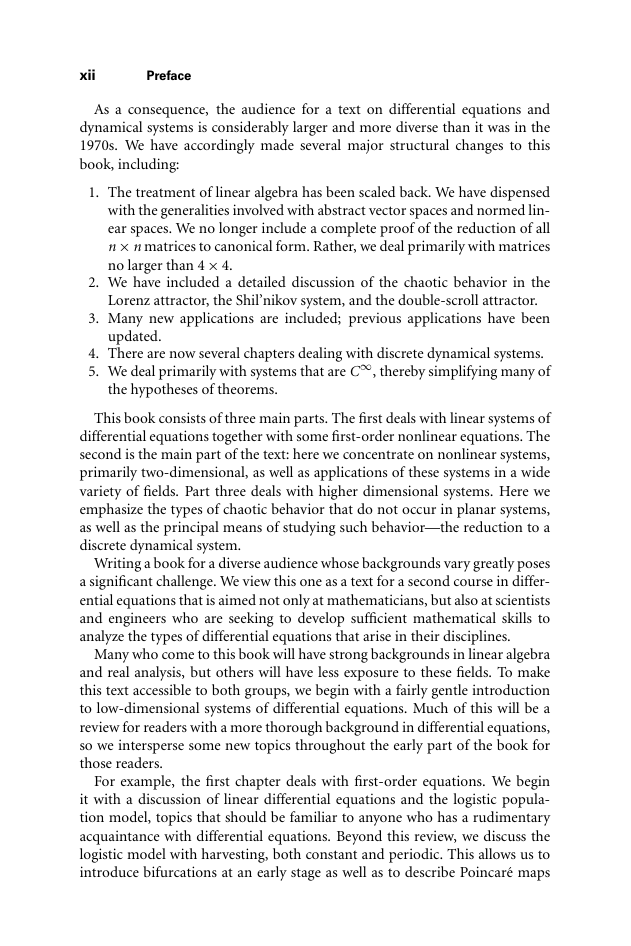
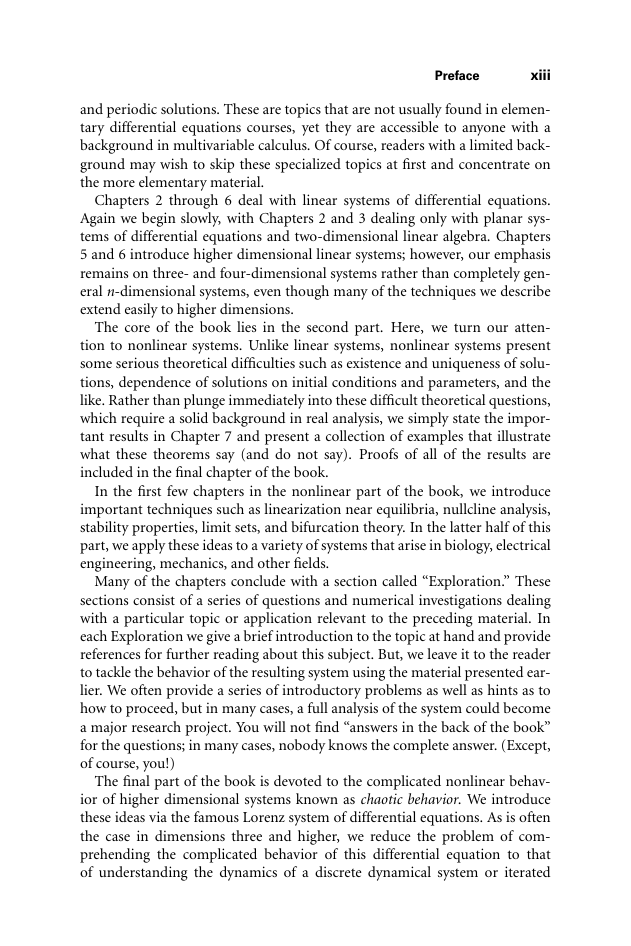
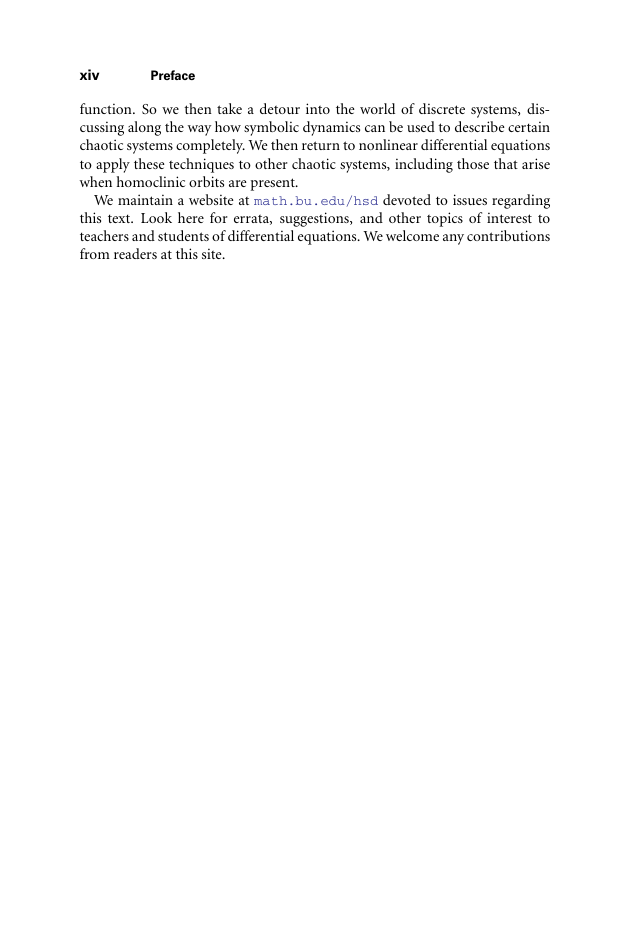
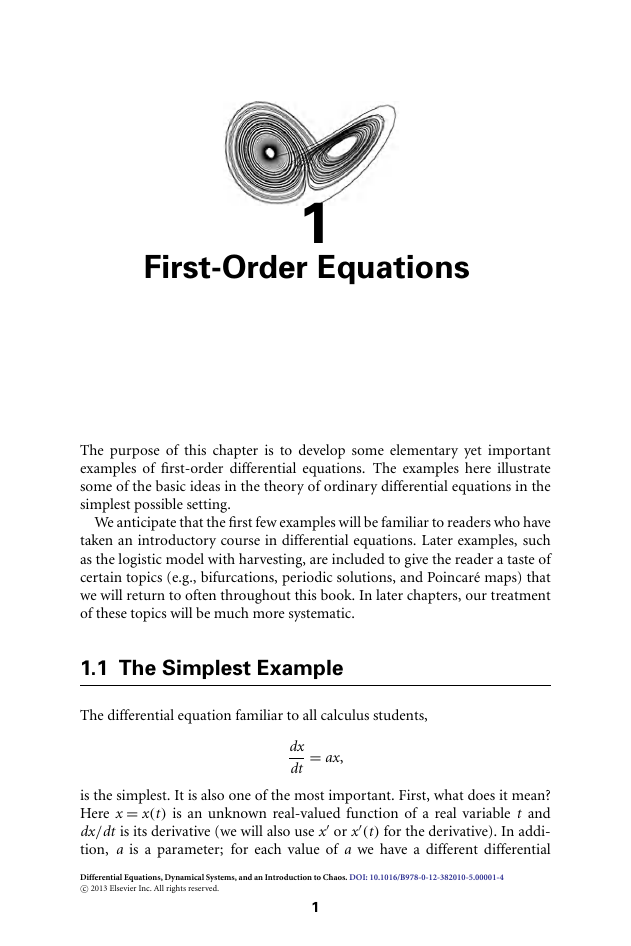








 2023年江西萍乡中考道德与法治真题及答案.doc
2023年江西萍乡中考道德与法治真题及答案.doc 2012年重庆南川中考生物真题及答案.doc
2012年重庆南川中考生物真题及答案.doc 2013年江西师范大学地理学综合及文艺理论基础考研真题.doc
2013年江西师范大学地理学综合及文艺理论基础考研真题.doc 2020年四川甘孜小升初语文真题及答案I卷.doc
2020年四川甘孜小升初语文真题及答案I卷.doc 2020年注册岩土工程师专业基础考试真题及答案.doc
2020年注册岩土工程师专业基础考试真题及答案.doc 2023-2024学年福建省厦门市九年级上学期数学月考试题及答案.doc
2023-2024学年福建省厦门市九年级上学期数学月考试题及答案.doc 2021-2022学年辽宁省沈阳市大东区九年级上学期语文期末试题及答案.doc
2021-2022学年辽宁省沈阳市大东区九年级上学期语文期末试题及答案.doc 2022-2023学年北京东城区初三第一学期物理期末试卷及答案.doc
2022-2023学年北京东城区初三第一学期物理期末试卷及答案.doc 2018上半年江西教师资格初中地理学科知识与教学能力真题及答案.doc
2018上半年江西教师资格初中地理学科知识与教学能力真题及答案.doc 2012年河北国家公务员申论考试真题及答案-省级.doc
2012年河北国家公务员申论考试真题及答案-省级.doc 2020-2021学年江苏省扬州市江都区邵樊片九年级上学期数学第一次质量检测试题及答案.doc
2020-2021学年江苏省扬州市江都区邵樊片九年级上学期数学第一次质量检测试题及答案.doc 2022下半年黑龙江教师资格证中学综合素质真题及答案.doc
2022下半年黑龙江教师资格证中学综合素质真题及答案.doc